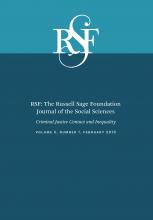Research Article
Open Access
Police Contact and the Legal Socialization of Urban Teens
Amanda Geller, Jeffrey Fagan
RSF: The Russell Sage Foundation Journal of the Social Sciences February 2019, 5 (1) 26-49; DOI: https://doi.org/10.7758/RSF.2019.5.1.02
Amanda Geller
aClinical associate professor of sociology at New York University
Jeffrey Fagan
bIsidor and Seville Sulzbacher Professor of Law and professor of epidemiology at Columbia University

REFERENCES
- ↵
- ↵
- Bank, Lewis I.,
- Thomas J. Dishion,
- Martie Skinner, and
- Gerald R. Patterson
- ↵
- Bell, Monica C
- ↵
- Berg, Mark T.,
- Eric A. Stewart,
- Jonathan Intravia,
- Patricia Y. Warren, and
- Ronald L. Simons
- ↵
- Braga, Anthony A., and
- David Weisburd
- ↵
- Brame, Robert W.,
- Michael G. Turner,
- Raymond Paternoster, and
- Shawn D. Bushway
- ↵
- ↵
- Brunson, Rod K., and
- Ronald Weitzer
- ↵
- Burt, Callie H.,
- Man Kit Lei, and
- Ronald L. Simons
- ↵
- Carr, Patrick J.,
- Laura Napolitano, and
- Jessica Keating
- ↵
- Dehejia, Rajeev H., and
- Sadek Wahba
- ↵
- ↵
- Eckhouse, Laurel
- ↵
- Epp, Charles R.,
- Steven Maynard-Moody, and
- Donald P. Haider-Markel
- ↵
- Fagan, Jeffrey
- ↵
- Fagan, Jeffrey, and
- Elliott T. Ash
- ↵
- Fagan, Jeffrey,
- Anthony A. Braga,
- Rod K. Brunson, and
- April Pattavina
- ↵
- Fagan, Jeffrey, and
- Amanda Geller
- ↵
- Fagan, Jeffrey,
- Amanda Geller,
- Garth Davies, and
- Valerie West
- ↵
- Fagan, Jeffrey, and
- Tracey L. Meares
- ↵
- ↵
- Fagan, Jeffrey, and
- Tom R. Tyler
- ↵
- Fagan, Jeffrey,
- Tom R. Tyler, and
- Tracey L. Meares
- ↵
- Feeley, Malcolm M
- ↵
- Fowler, Deborah,
- Rebecca Lightsey,
- Janis Monger, and
- Elyshia Aseltine
- ↵
- Gau, Jacinta M., and
- Rod K. Brunson
- ↵
- Geller, Amanda
- ↵
- Geller, Amanda,
- Jeffrey Fagan, and
- Tom R. Tyler
- ↵
- ↵
- Harcourt, Bernard E
- ↵
- Harris, Alexes
- ↵
- Harris, Kathleen M.,
- Penny Gordon-Larsen,
- Kim Chantala, and
- J. Richard Udry
- ↵
- Hatzenbuehler, Mark L.,
- Katie A. McLaughlin,
- Katherine M. Keyes, and
- Deborah S. Hasin
- ↵
- Heymann, Philip B
- ↵
- Hill, Shirley A
- ↵
- Justice, Benjamin, and
- Tracey L. Meares
- ↵
- Kelling, George L., and
- Catherine M. Coles
- ↵
- Kelling, George L., and
- James Q. Wilson
- ↵
- Kirk, David S., and
- Mauri Matsuda
- ↵
- ↵
- ↵
- Kohler-Hausmann, Issa
- ↵
- Krieger, Nancy
- ↵
- Kubrin, Charis E.,
- Steven F. Messner,
- Glenn Deanne,
- Kelly McGeever, and
- Thomas D. Stucky
- ↵
- Kupchik, Aaron
- ↵
- Langton, Lynn, and
- Matthew R. Durose
- ↵
- Livingston, Debra
- ↵
- Massey, Douglas S., and
- Nancy A. Denton
- ↵
- Na, Chongmin, and
- Denise C. Gottfredson
- ↵
- Nance, Jason P
- ↵
- New York City Police Department (NYPD)
- ↵
- Owens, Emily G
- ↵
- ↵
- Piquero, Alex R.,
- Jeffrey Fagan,
- Edward P. Mulvey,
- Laurence Steinberg, and
- Candice Odgers
- ↵
- Reichman, Nancy,
- Julien Teitler,
- Irwin Garfinkel, and
- Sara McLanahan
- ↵
- Rocque, Michael, and
- Raymond Paternoster
- ↵
- ↵
- Sampson, Robert J., and
- Dawn J. Bartusch
- ↵
- Sampson, Robert J., and
- Jeffrey D. Morenoff
- ↵
- Sawyer, Pamela J.,
- Brenda Major,
- Bettina J. Casad,
- Sarah S.M. Townsend, and
- Wendy Berry Mendes
- ↵
- ↵
- Sewell, Abigail A., and
- Kevin A. Jefferson
- ↵
- ↵
- Sharkey, Patrick
- ↵
- Shedd, Carla
- ↵
- Skogan, Wesley G., and
- Kathleen Frydl
- ↵
- Soss, Joe, and
- Vesla Weaver
- ↵
- Stewart, Eric A.,
- Eric P. Baumer,
- Rod K. Brunson, and
- Ronald L. Simons
- ↵
- ↵
- Taylor, Ralph
- Trinkner, Rick,
- Jonathan Jackson, and
- Tom R. Tyler
- ↵
- Tyler, Tom R
- ↵
- Tyler, Tom R., and
- Jeffrey Fagan
- ↵
- Tyler, Tom R., and
- Yuen J. Huo
- ↵
- ↵
- U.S. Department of Justice
- ↵
- U.S. Department of Justice
- ↵
- U.S. Department of Justice
- ↵
- Weisburd, David L., and
- Malay K. Majmundar
- ↵
- Weitzer, Ronald, and
- Steven A. Tuch
- ↵
- Weitzer, Ronald,
- Steven A. Tuch, and
- Wesley G. Skogan
- ↵
- ↵
- White, Michael D., and
- Henry Fradella
- ↵
- Zimroth, Peter L
In this issue
Police Contact and the Legal Socialization of Urban Teens
Amanda Geller, Jeffrey Fagan
RSF: The Russell Sage Foundation Journal of the Social Sciences Feb 2019, 5 (1) 26-49; DOI: 10.7758/RSF.2019.5.1.02
Jump to section
Related Articles
- No related articles found.
Cited By...
- No citing articles found.





